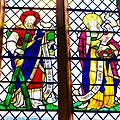
Peterhouse is the oldest constituent college of the University of Cambridge in England, founded in 1284 by Hugh de Balsham, Bishop of Ely. Today, Peterhouse has 254 undergraduates, 116 full-time graduate students and 54 fellows. It is quite often erroneously referred to as Peterhouse College, although the correct name is simply Peterhouse.

Corpus Christi College is a constituent college of the University of Cambridge. From the late 14th century to the early 19th century it was also commonly known as St Benet's College.
Richard Crashaw was an English poet, teacher, High Church Anglican cleric and Roman Catholic convert, who was one of the major metaphysical poets in 17th-century English literature.
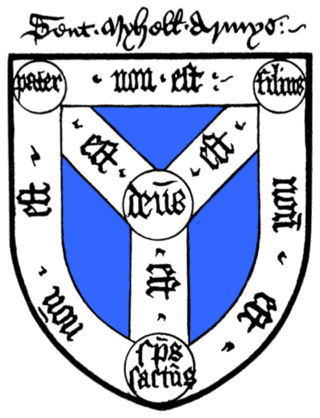
Michaelhouse is a former college of the University of Cambridge, that existed between 1323 and 1546, when it was merged with King's Hall to form Trinity College. Michaelhouse was the second residential college to be founded, after Peterhouse (1284). Though King's Hall was established earlier in 1317, it did not acquire actual premises until its re-foundation by Edward III in 1336. The name Michaelhouse is now used for St Michael's Church.
William Dowsing (1596–1668), also known as "Smasher Dowsing", was an English puritan, and a particularly notable iconoclast at the time of the English Civil War. He was mainly active in East Anglia.

St Mary's Church, Barnes, is the parish church of Barnes, formerly in Surrey and now in the London Borough of Richmond upon Thames. It is a Grade II* listed building.
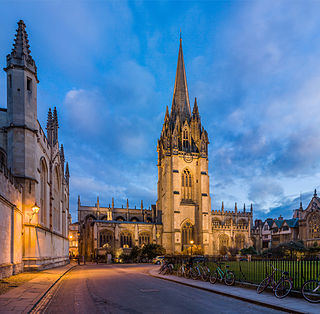
The University Church of St Mary the Virgin is an English church in Oxford situated on the north side of the High Street. It is the centre from which the University of Oxford grew and its parish consists almost exclusively of university and college buildings.

Trumpington is a village to the south of Cambridge, in the Cambridge district, in the county of Cambridgeshire, England. The village is an electoral ward of the City of Cambridge and a ward of South Cambridgeshire District Council. The 2011 Census recorded the ward's population as 8,034.

English Gothic is an architectural style that flourished from the late 12th until the mid-17th century. The style was most prominently used in the construction of cathedrals and churches. Gothic architecture's defining features are pointed arches, rib vaults, buttresses, and extensive use of stained glass. Combined, these features allowed the creation of buildings of unprecedented height and grandeur, filled with light from large stained glass windows. Important examples include Westminster Abbey, Canterbury Cathedral and Salisbury Cathedral. The Gothic style endured in England much longer than in Continental Europe.

Saint Chrysostom's Church is the Anglican parish church in Victoria Park, Manchester, England. The church is of the Anglo-Catholic tradition, and also has a strong tradition of being inclusive and welcoming.
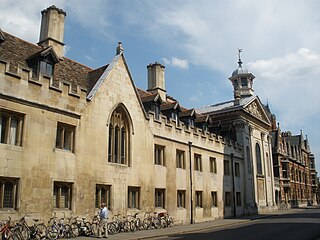
Trumpington Street is a major historic street in central Cambridge, England. At the north end it continues as King's Parade where King's College is located. To the south it continues as Trumpington Road, an arterial route out of Cambridge, at the junction with Lensfield Road.

John Edmunds was master of Peterhouse, Cambridge.
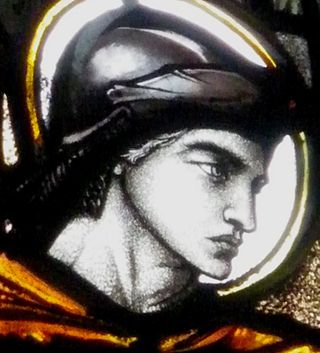
Rachel de Montmorency, née Rachel Marion Tancock, was an English painter and artist working in stained glass. She learned about stained glass when she worked for artist Christopher Whall in the 1910s and 1920s. During World War I she worked as a voluntary nurse.

St Mary and St Peter's Church is a Grade I listed Church of England parish church dedicated to Saint Mary and Saint Peter in Harlaxton, Lincolnshire, England. The church is 2 miles (3 km) south-east from Grantham, and at the eastern edge of the Vale of Belvoir in South Kesteven.

The Church of St Mary of the Assumption is in Yorkshire Street, Burnley, Lancashire, England. It is an active Roman Catholic parish church in the diocese of Salford. The church is recorded in the National Heritage List for England as a designated Grade II listed building. It was built between 1846 and 1849 to replace a smaller chapel on a different site. The church was designed by Weightman and Hadfield in Decorated style, and a chapel was added to it in 1879.
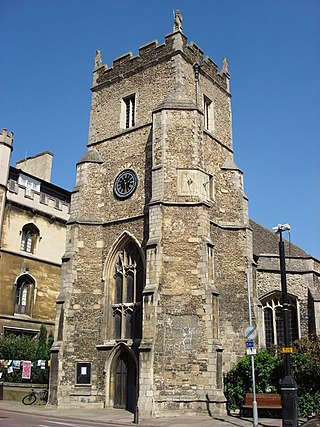
St Botolph's Church, Cambridge is a Church of England parish church in the city of Cambridge, England. The church is a Grade I listed building.

The Church of St Gregory, Sudbury is a Church of England parish church, located in the town of Sudbury in Suffolk, England. First mentioned in the 10th century, most of the present building dates from the 14th and 15th centuries. The church famously possesses the head of Archbishop Simon Sudbury, who was beheaded by rebels during the Peasants' Revolt in 1381. It is a Grade I listed building.

Henry Castree Hughes, known as H. C. Hughes or Hugh Hughes, was a British architect and conservationist. He spent his entire career in Cambridge, where he practised architecture from 1923, latterly as Hughes and Bicknell with Peter Bicknell, and lectured in design at the School of Architecture of the University of Cambridge (1919–32). As an architect, he is best known for his Modernist buildings of the 1930s, particularly the Mond Building (1931–32) and Fen Court, Peterhouse (1939–40), although much of his output was traditional in style. He also carried out restoration work on cottages, Cambridge college buildings, and churches, including the Lady Chapel of Ely Cathedral. He was an elected fellow of the Royal Institute of British Architects.









